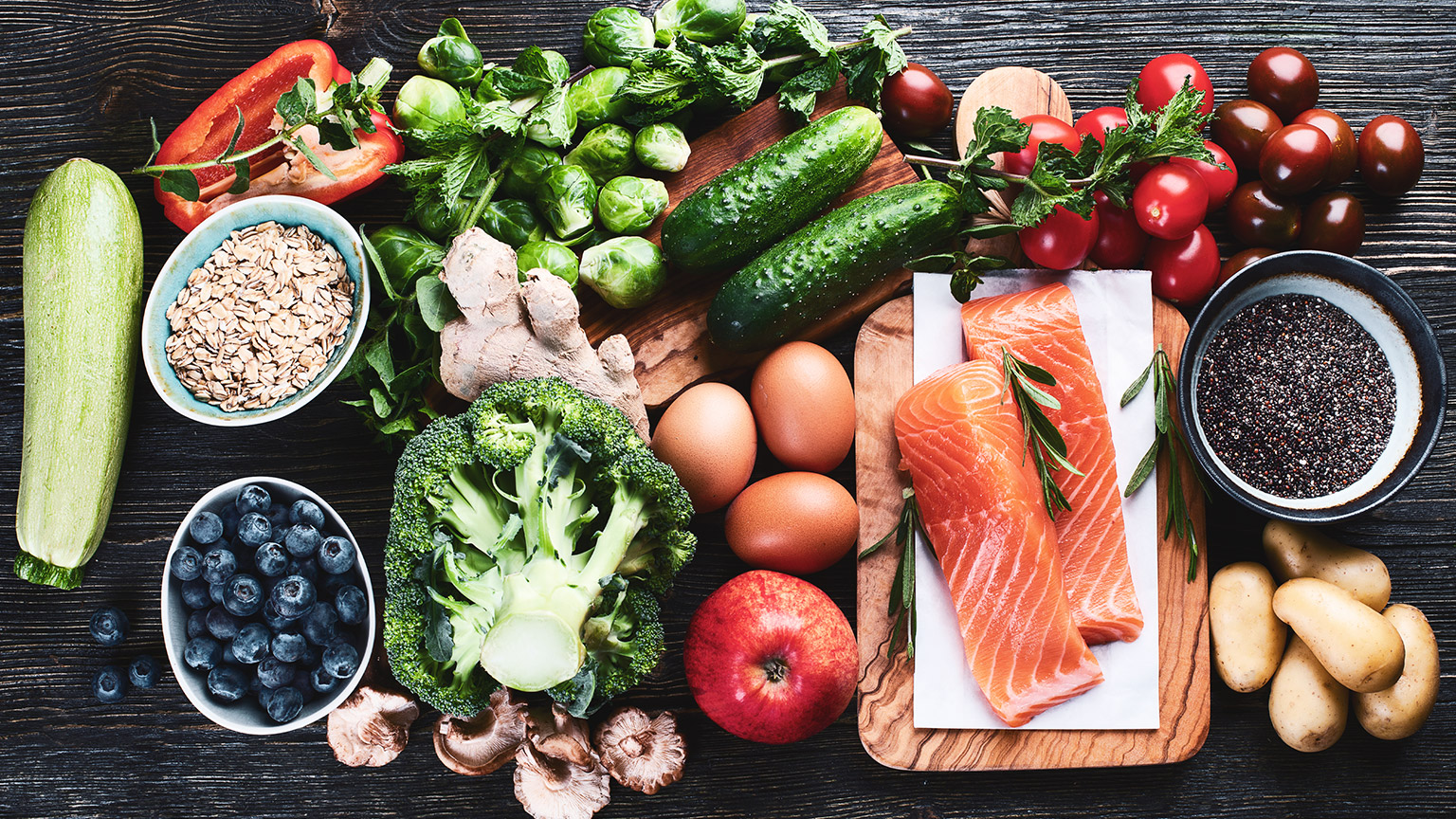In this topic, we focus on the role of vitamins and minerals and their contribution to a nutritious diet.
You will learn:
- vitamins
- water-soluble and fat-soluble vitamins
- fortified food & supplements
- minerals
- major minerals
- trace minerals
- supplements
Terminology and vocabulary reference guide
As an allied health professional, you need to be familiar with terms associated with nutrition principles and use the terms correctly (and confidently) with clients, your colleagues, and other allied health professionals. You will be introduced to many terms and definitions. Add any unfamiliar terms to your own vocabulary reference guide.
Activities
There activities and an automated quiz at the end of this topic. This is not part of your assessment but will provide practical experience that will help you in your work and help you prepare for your formal assessment.
In total, there are approximately 13 different vitamins which sit within the groups vitamin A, B, C, D, E, and K. Vitamins have different roles that vary from blood clotting procedures to helping resist infection. Vitamins are an essential compound in trace amounts for metabolic reactions such as digestion, CHO and fat mobilization, bone growth and improving the immune system.
A sufficient balance of vitamins and minerals are required for the body to achieve and maintain internal homeostasis (balance) of cellular and metabolic functions for day to day physiological requirements. When performing physical activity or exercise, the body is put under further ‘stress’, therefore, it is hugely important to ensuring the body has all the tools it requires in order to offer us the ultimate payback- good health!
Whilst vitamins are metabolized by the body for essential physiological processes it is important to note that some vitamins are not produced in significant enough amounts by the body, or not at all, therefore these must be ingested.
Deficiency of vitamins leads to deficiency diseases while excess can lead to toxicity. There are Recommended Daily Allowance (RDA) that are measured in either Milligrams (mg): One-thousandth of a gram or Micrograms (mcg/μg): one-millionth of a gram.
Let’s begin by looking at the different classification of vitamins.
Water-soluble and Fat-Soluble Vitamins
Vitamins are grouped based on characteristics such as their action and their method of storage, for example, typical classification is either water-soluble or fat-soluble each providing different benefits to the body.
Let’s look at the main difference between these vitamin types.
Water-soluble Vitamins
Water-soluble vitamins are not stored by the body, instead, they are transported to the cells and tissues of the body via water within the body such as blood, interstitial fluid and excreted via the urine. As these vitamins are not stored, they need to be regularly (daily) incorporated into the diet. Typically, water-soluble vitamins can be found in plant material, animal-based food or also in dietary supplements.
Fun Facts
- Vitamin C and members of the vitamin B complex are classified as water-soluble
- Vitamin B supports energy metabolism
- Vitamin C assists in maintaining the structure in bone, cartilage, and connective tissue
- Many of the B vitamins are lost in cooking when food is heated.
- Vitamin B3 is an “essential nutrient” meaning that it is not produced by the body therefore it must be obtained from the diet.
- B7 (biotin) is received in ample amounts though a sufficient diet and typically is only taken in supplement form upon recommendation from a medical professional.
The information below regarding the benefits and storage classification of the following vitamin types will be useful and regularly called upon when providing your clients with nutritional guidance in support of their training goals.
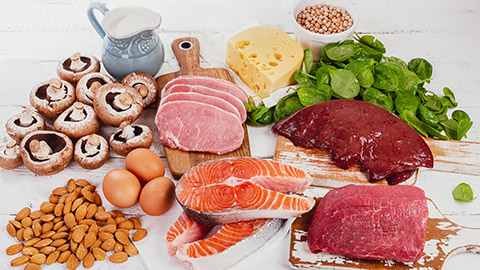
Vitamin B
The B-complex vitamins are a group of eight vitamins, which include:
- thiamine (B1)
- Function: supports the nervous system function and enhances digestion.
- Dietary sources: pork, organ meats, whole grains, legumes, brown rice, pasta, green vegetables, fish, beans, nuts, eggs.
- RDA: adult dosage = 1-2mg depending on age, gender and pregnancy or breastfeeding (reproductive) status.
- Deficiency: can lead to beri-beri (a disease-causing inflammation of the nerves and heart failure).
- Toxicity: N/A
- riboflavin (B2)
- Function: supports the overall maintenance of the body, assists carbohydrate, protein and fat breakdown for energy, it enhances digestion, supports the development of the nervous and immune system.
- Dietary sources: wholemeal grains, liver, green vegetables, milk and eggs.
- RDA: adult dosage = 1.1-1.3 mg depending on age, gender and reproductive status.
- Deficiency: Reddened lips or anemia.
- Toxicity: N/A
- niacin (B3)
- Function: supports the maintenance of the body, assists carbohydrate, protein and fat breakdown for energy, it enhances digestion, supports the development of the nervous and immune system.
- Dietary sources: liver, lean meats, grains, legumes, poultry, fish, nuts, cereals, avocados, prunes, figs.
- RDA: adult dosage = 14-16 mg depending on age, gender and reproductive status.
- Deficiency: can lead to Pellagra (characterised by the 4 D’s- dermatitis, diarrhea, dementia and death).
- Toxicity: diarrhea, liver damage, gout, rapid heartbeat, itching, severe flushing of the skin accompanied by dizziness, abdominal pain, nausea and vomiting and other side effects.
- pantothenic acid (B5)
- Function: supports stress, enhances digestion, helps produce sex hormones, supports the development of the nervous system, adrenal gland function and antibody formation.
- Dietary sources: meats, legumes, wholegrain cereals, vegetables, bran, offal, yeast, nuts, and chicken.
- RDA: adult dosage = 1.7-7mg depending on age, gender and reproductive status.
- Deficiency: none known
- Toxicity: diarrhea, malaise (general feeling of being unwell), irritability, vomiting, stomach pains and other side effects.
- pyridoxine (B6)
- Function: enhances digestion, production of red blood cells and antibodies, supports nervous system function and the production of serotonin (mood hormone)
- Dietary sources: whole grains, vegetables, liver, chicken, pork, wheat germ, potatoes and bananas.
- RDA: adult dosage = 1-100mg depending on age, gender and reproductive status.
- Deficiency: muscle twitching, skin rashes, cracked or sore lips, mood changes, weakened immune system function, fatigue and tingling the hands and or feet.
- Toxicity: none known
- biotin (B7)
- Function: aids in the formation of fatty acids and glucose (an essential building block for metabolic and physiological processes), aids in the metabolising) of carbohydrates and amino acids along with a breakdown of fat in the body. Biotin also contributes to the prevention of baldness and grey hairs, known to alleviate dermatitis.
- Dietary sources: liver, egg yolk, mushrooms, peanuts, bananas, grapefruit, watermelon and dried beans
- RDA: adult dosage = no real recommendation available as typically we obtain enough from our diet, should supplementation be required, this would be advised by a medical professional and dosage will be advised in accordance with medical advice.
- Deficiency: dermatitis, hair loss or hair thinning, heart problems.
- Toxicity: as supplementation would be rare as enough biotin is received through a balanced diet, toxicity is less likely than other B group vitamins. Supplementation would be guided through the advice of a medical professional only.
- folic acid (B9)
- Function: vital for growth and reproduction, supports the nervous system function along with blood cell production.
- Dietary sources: yeast, liver, green vegetables, wholegrain cereals, nuts and egg yolks.
- RDA: adult dosage = 400 mcg (micrograms), women who are planning pregnancy are typically advised on levels between 400-800 mcg per day to support reproductive status.
- Deficiency: anemia, poor grown and development, mood swings
- Toxicity: convulsions, sleep disorders, skin rashes, nausea, gas, seizures, cramps, diarrhea and other side effects.
- cyanocobalamin (B12)
- Function: vital for growth and development, supports red blood cell production and well as utilization of folic acid.
- Dietary sources: liver, kidney, eggs, fish, milk, dairy products, brewers yeast, fortified soy products and fortified breakfast cereals.
- RDA: adult dosage = 400 mcg (micrograms), women who are planning a pregnancy are typically advised on levels between 400-800 mcg per day to support reproductive status.
- Deficiency: anemia, poor grown and development, mood swings
- Toxicity: convulsions, sleep disorders, skin rashes, nausea, gas, seizures, cramps, diarrhea and other side effects.
B group benefits
- Aids in stress relief (B1, B2, B3, B6 and B12).
- Strengthens the brain function
- Directly impacts energy levels
- Helps prevent or fight infection
- Aids in the breakdown of fats and proteins (which aids the normal functioning of the nervous system).
- Aids in muscle tone in the stomach and intestinal tract. Maintenance of skin, hair, eyes, mouth and liver.
- Aids in the breakdown of carbohydrates into glucose (this provides energy for the body).

Vitamin C
Function: essential for the formation of connective tissue and hormones, antioxidant, increases iron absorption.
Dietary sources: citrus fruits, green vegetables. (we are unable to synthesize vitamin C, therefore, it must be eaten).
RDA: 60- 90 milligrams.
Deficiency: scurvy: poor wound healing, bleeding gums, joint pain.
Toxicity: greater than 1000mg per day can be toxic and can cause nausea, abdominal cramps, diarrhea, headache, fatigue and insomnia
Vitamin C benefits
- Boosts immunity
- Aids in managing high blood pressure
- Improves the skin complexion and protects it from free radicals
- Helps in preventing gout with the reduction of uric acid levels in the body
- Prevents anemia as it assists in iron absorption in the body
- Reduces the risk of chronic diseases including heart disease
Fat-Soluble Vitamins
Fat-soluble, as the name suggests, are vitamins that dissolve/are stored in the fat cells within the body. These vitamins typically come from plant and animal-based foods or dietary supplements. Vitamins are not readily excreted from the body and can cause toxicity if they exceed the RDA.
Fun Facts
- Vitamins A, D, E and K are classified as fat-soluble vitamins
- All fat-soluble vitamins except Vitamin K, can be stored in the body in meaningful amounts, so deficiency takes longer.
- Fat-soluble vitamins are absorbed in the small intestines alongside fat and are stored in body fat (adipose cells) and the liver.
- Excess intake can be toxic (toxicity can occur at approximately 4-5 x RDA), therefore it is important to ensure intake levels are monitored.
Let’s take a look below at each of the fat-soluble vitamins, paying particular attention to their sources, deficiencies and function.

Vitamin A
Function: promotes better vision, cell growth and resistance to bacterial infection.
Dietary sources: liver, milk, breakfast cereals, green vegetables, carrots.
RDA: 750 micrograms
Deficiency: poor vision, susceptibility to infection.
Toxicity: 10,000 mgs per day - fatigue, dry skin, loss of appetite, headaches.
Vitamin A benefits
- Assists with maintaining healthy vision
- Aids in healthy skin, bones and other tissues in the body.
- Vitamin A is an antioxidant, fighting cell damage from free radicals.

Vitamin D
Function: facilitates the absorption of calcium and phosphorous into bones.
Dietary sources: milk, breakfast cereals, fish, sunlight.
RDA: 5-10 micrograms.
Deficiency: weakening or misshaping of bones.
Toxicity: calcification of soft tissue, growth retardation, kidney stones.
Vitamin D benefits
- Maintains the health of bones, teeth and muscles
- Can reduce the risks of cancer when taken alongside calcium
- Reduces cardiovascular build-up, reducing cardiovascular disease
- Supports pregnancies by preventing pre-eclampsia and gestational diabetes.

Vitamin E
Function: Is an antioxidant, therefore, it protects from the damage oxygen radicals & toxic chemicals can make, the formation of haemoglobin.
Dietary sources: vegetable oils, breakfast cereals, fruit & vegetables, nuts.
RDA: 10-20 milligrams per day
Deficiency: RBC breakdown, nerve, and muscle cell damage.
Toxicity: 300 mg per day - limits vitamin K uptake.
Vitamin E benefits
- Slows down the ageing process to all cells in the body
- Repairs cell damage done by UV rays
- Prevents the risk of diseases such as heart disease and cancer
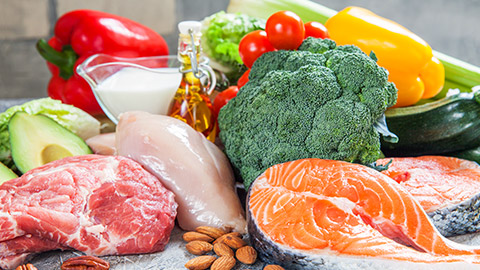
Vitamin K
Function: makes protein for the formation of normal blood clots and bone formation.
Dietary sources: green vegetables, meats and dairy products.
RDA: 60-80 micrograms
Deficiency: hemorrhaging, blood loss, anemia.
Toxicity: very rare.
Vitamin K benefits
- Makes proteins for healthy bones
- Regulates blood calcium levels
- Improves memory
Fortified Food & Supplements
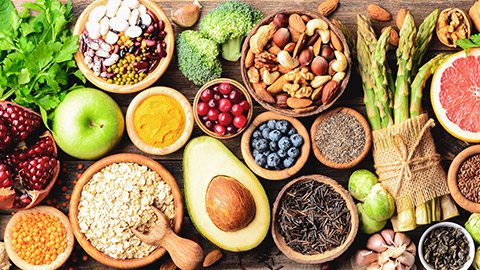
Supplements
When vitamins from food are difficult to obtain or insufficient in amount, people can turn to supplements and fortified foods to replenish their nutritional needs.
Supplements are the synthetic versions of vitamins naturally found within the food we eat. They generally would come in a pill form and taken orally. It is generally accepted that vitamins are best absorbed with real food as it has less risk of exceeding the RDA. However, there is growing evidence that certain B vitamins may be better absorbed in supplement form (particularly B12) as it is in free form rather than needing the bodies’ system to release it.
Fortified Foods
Fortified foods are those that contain vitamins that have been added back in during processing, in most cases, they are cheap, synthetic vitamin forms. Natural vitamins, on the other hand, are slightly more expensive, and in some cases work hundreds of times better as they are in their truer form giving greater benefits. Fortified food aims to enrich foods with additional vitamins or macronutrients to supplement any dietary deficiencies. Check the label on many "fortified" foods. There might be some basic vitamins that have been added but remember that processing, heat, and light destroys many vitamins. In addition to that, water-soluble vitamins often leech out during the cooking process. So be aware that many fortified foods may not have the same benefits as vitamins gained from food or supplements.

Pregnancy and Folic Acid
Folic acid is the synthetic form of folate, which can be found naturally in B vitamins. Folate is a supplement especially important in prenatal health. The importance of folic acid has been proven to prevent neural tube defects and is needed for healthy growth and development of the baby. A high percentage of birth defects are caused by vitamin B deficiency.
Seniors and Vitamins
Seniors, above all others, need to be aware of their vitamin needs. As people age, the body not only produces fewer vitamins, but it also absorbs the essential vitamins (the ones the body cannot make) less, especially B vitamins. This means that it is important for seniors to supplement with the correct vitamins daily for optimum physiological functions such as digestion, muscular contraction, never signaling as well as general health.
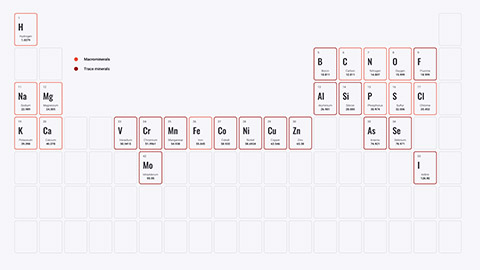
Minerals are naturally occurring inorganic elements that are important in the structure and function of the body by providing strength in bones and teeth and maintaining the bodily fluids in and around the cells. Additionally, minerals are useful in converting food into energy. When There are Recommended Daily Allowance (RDA) and Recommended Dietary Intakes (RDI) for minerals we must be aware of to avoid toxicity from a large consumption.
Types of Minerals
Minerals are required in the diet to ensure supply as the body does not produce them naturally. There are 2 main minerals to be aware of. These are major minerals (macrominerals) and trace minerals (microminerals).
Major minerals are needed in our diet in larger amounts while trace minerals are needed in smaller amounts.
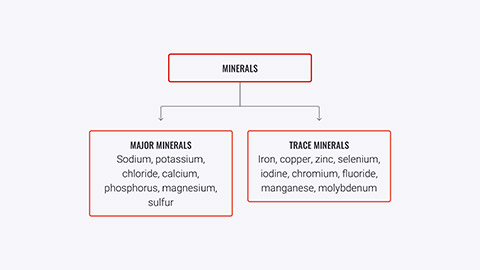
Let’s have a look at the major minerals and trace minerals, what they do in the body (their functions), and their sources in food.
Major Minerals

Sodium
Sodium is required for initiation of nerve signalling and muscular contraction, it also determines the level of water in the body (extracellular). It is one of the main ingredients in salt, however, there is enough sodium found in food that there is no need to add salt to it. Salt is used for personal preference in taste within a meal but not a necessity. A good tip to follow when cooking is to taste the food before adding salt, stocks and sauce mixes when cooking.
Dietary sources: sodium is found in table salt, salted meats, frozen dinners, canned beans, olives, cheese, sauces and salted nuts.
RDA: 920 - 2300mg
Stored: sodium is stored in the blood and extracellular fluid, sodium is lost in sweat during exercise thus needs to be replaced.
Deficiency: causes low extracellular fluid - drop in blood pressure.
Toxicity: causes hypertension (high blood pressure). A major problem in society today.
Sodium benefits
- prevents low blood pressure
- enough sodium can be found in many meals so no need to add salt.
- the body uses sodium to maintain fluid levels.
Salt Tips and Guidelines
- taste food before adding salt, stocks and sauce mixes when cooking. Herbs and spices can be added to add flavour instead.
- avoid eating meals that have added salts.
- avoid foods that are high in salt such as chips, roasted peanuts, pickled foods, soy sauce, 2-minute noodles, processed meats (luncheon / salami), packet soups, takeaway foods.
Chloride
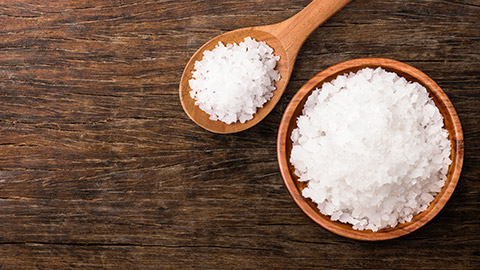
Chloride is a major electrolyte that is vital in the balancing of fluid in the human body, particularly in regard to the fluid composition inside and outside the cells. It is an essential part of fluids (stomach acid) during the digestive process and gets flushed out of the body through urine. Chloride also assists in maintaining optimal blood volume, blood pressure and the pH of the cells withing the body.
Dietary sources: chloride can be found in table salt or sea salt as sodium chloride, seaweed, rye, tomatoes, lettuce, celery, olives and salt substitutes (normally chloride is combined with potassium).
RDA: 2300mg
Stored: chloride is found in the blood, and extracellular fluid.
Deficiency: N/A
Toxicity: excess amounts of chloride can increase the risk of heart disease. You can offset the effects of large amounts of sodium chloride by including sufficient potassium in diet.
Chloride benefits
- acts as the most important electrolyte in the body of the body, regulating the fluids in the inner and outer cells.
- maintains the volume, pressure and PH balance of blood.
Phosphorus

Phosphorus works alongside calcium and together they assist with keeping teeth and bones healthy along with supporting their structure and formation. It contributes to growth, maintenance and repair of tissue cells and aids with providing energy to the cells. Something you might not be aware of is that our clever body uses our kidneys to control the amount of phosphate in the blood and the excess is expelled through urine.
Dietary sources: phosphorus can be found in meat, fish, poultry, eggs, milk and processed foods (including soda)
RDA: 700mg
Stored: phosphorus is stored in teeth and bones
Deficiency: N/A
Toxicity: the kidney removes most of it from the body making toxicity rather low risk, however, if there does happen to be high amounts of phosphorus in the body, (normally due to a kidney disfunction) It can lead to losing bone density as the kidneys are not properly removing high amounts ingested.
Phosphorus benefits
- manages how the body stores and uses energy
- helps to grow, maintain, and repair tissue and cells.
- reduces muscle aches after physical activity
- filters out waster through kidney
- works alongside calcium for strong bones and teeth
Sulphur
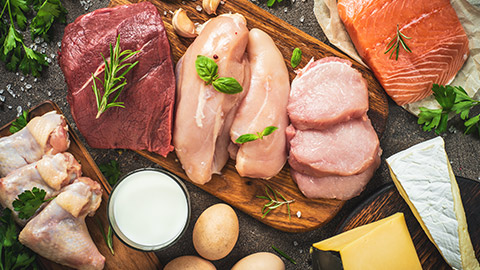
Sulphur helps metabolise food and helps in maintaining the integrity of skin, tendons, and ligaments.
Dietary sources: sulphur can be obtained from garlic, onions, eggs, and protein-rich foods
RDA: 14 mg/Kg of body weight
Stored: sulphur can be found within all body cells before getting eliminated the excess amounts through urine and faeces.
Deficiency: reduced protein synthesis can result in painful joints.
Toxicity: high amounts of Sulphur can damage brain cells and may also cause diarrhoea.
Sulphur benefits
- provide strength to hair skin and nails
- repairs damaged cells
Calcium
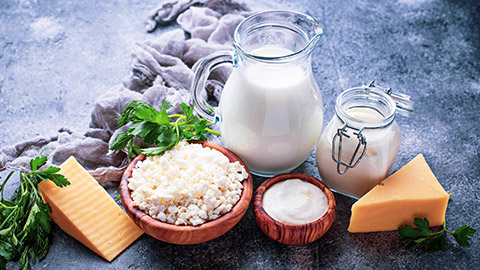
Calcium plays a very important role in the formation and maintenance of strong and healthy bones and teeth. This is a vital mineral particularly for young children and adolescents as their bone growth and formation continues to the age of approximately 20 years old and also at the other end of the spectrum when considering the elderly who are more susceptible to condition of bone wasting such as osteoporosis, osteoarthritis and the like.
Dietary sources: calcium is found mainly in milk and dairy products such as and yoghurt.
Also found in nuts and leafy green vegetables – such as broccoli and cabbage but not spinach.
RDA: 1000-1200 mg per day
Stored: calcium is stored in bones and muscle, bones act as the largest reservoir of calcium in the body.
Deficiency: deficiency is a factor in osteoporosis.
Toxicity: N/A
Calcium benefits
- lowers blood pressure
- strengthens bone density, why it is recommended for those with loss of bone mass such as the elderly benefits highly from Calcium
- prevents osteoporosis
Potassium
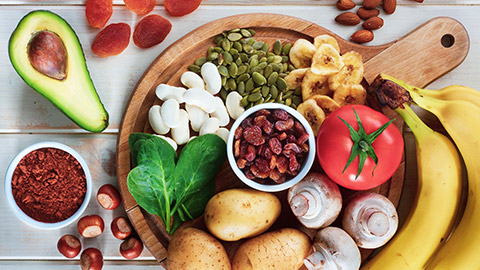
Potassium is another electrolyte that can assist in balancing the body’s fluids, and in this case, it assists in preventing a fluid build-up (water retention) and reducing blood pressure in the body. Potassium is a vital player in physiological processes such as nerve transmission, cellular signalling, nerve conduction and muscle contraction, it also plays a role in reducing the likelihood of muscle loss.
Dietary sources: potassium can be found in bananas, raisins, apricots, oranges, avocadoes, dates, watermelon, prunes, broccoli, spinach, carrots, potato, sweet potato, mushrooms, peas, lentils, dried beans, peanuts, milk, yogurt, lean meats.
RDI: 4.7g per day
Stored: the majority of potassium is stored within muscle cells, and the remaining can be found in your bones, liver, and red blood cells.
Deficiency: can result in fatigue, muscle cramps and abnormal heart rhythms.
Toxicity: large amounts can result in heart palpitations, shortness of breath, chest pain, nausea or vomiting.
Potassium benefits
- aids in reducing blood pressure
- regulates water retention
- maintains normal heart rhythm (electrical) by regulating nerve signal and regulates muscle contractions.
- potassium functions as an electrolyte.
Magnesium
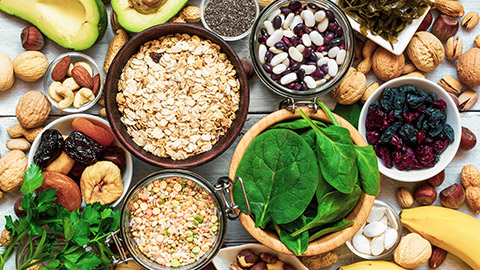
Magnesium is quite a multi-functional mineral and is responsible for protein synthesis which helps in maintaining the health of all our cells in the body. Since magnesium is also responsible for energy metabolism, regulating nerve transmission and muscle function, a lack of magnesium can result a decreased appetite, poor body coordination and muscle spasms.
Dietary sources: magnesium can be found in soya beans, yeast, whole-grains, nuts, meat, milk, fish, raisins, potatoes, and vegetables (leafy greens)
RDI: 270mg (women), 320mg (men)
Stored: more than half of magnesium in the body is found within the bones, the remaining in the muscles, soft tissues and fluids, including blood.
Deficiency: the body may tremble and have impaired balance, muscle spasms, loss of appetite and personality changes.
Toxicity: heart disturbances, breathing difficulties, poor reflexes, confusion, weakness, flushing (warmth, redness, or tingly feeling), sweating and lowered blood pressure.
Magnesium benefits
- increases performance levels
- alleviates and assists people who suffer from migraines
- alleviates depressions
- is an anti-inflammatory
- regulates muscle contraction and nerve transmission
- assists in regulating blood pressure
Trace Minerals
Zinc

Zinc supports physiological functions such as tissue growth and repair. It is a constituent of digestive enzymes and plays a role in your sense of taste and smell. Zinc is also vital for human growth and development, particularly during foetus formation during pregnancy.
Dietary sources: zinc can be found in some seafood (especially shellfish), animal products, cashews, peanuts, almonds.
RDI: 8 mg (women), 11 mg (men)
Stored: zinc is mainly stored in the bone and muscles
Deficiency: can result in growth delay, loss of appetite, and weakened immune function
Toxicity: ingestion great than 50 mg can result in nausea, vomiting, pain, cramps and diarrhea.
Zinc benefits
- aids in maintain a healthy immune system
- plays a role in wound healing
- supports growth and development of the human body, particularly during pregnancy
Iron
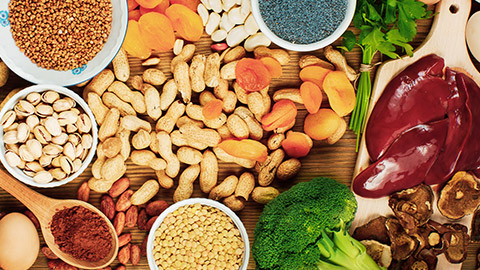
Iron helps transport O2 around the body. Iron aids in the attachment of O2 to the Haem portion of the blood which then enables oxygen to be transported from the lung to the body tissues via the blood and blood vessels. If insufficient amounts of iron are consumed, this can result in impacting the oxygen levels within the muscles, preventing them from functioning optimally.
There are 2 different types of iron. These are:
- Haem: is easily absorbed by the body
- Non-haem: not absorbed as well as haem iron, by the body.
Dietary sources:
Haem: is only found in meat, chicken and fish
Non-haem: found in plant foods, such as vegetables, cereals, beans and lentils
RDA: 7-10 mg (male), 12-15 mg (female)
Stored: iron is mostly stored in the liver, in the form of ferratin which is then later metabolised as applicable depending on the method of transport required to enable iron to reach the relevant destination.
Deficiency: may lead to anaemia and cause fatigue
Toxicity: harm to the gastrointestinal system can cause nausea, vomiting, diarrhea and stomach aches.
Iron benefits
- aids in maintaining a healthy immune system
- consume along with vitamin C – helps absorption
- aids in focus and overall energy
- regulates body temperature
Molybdenum
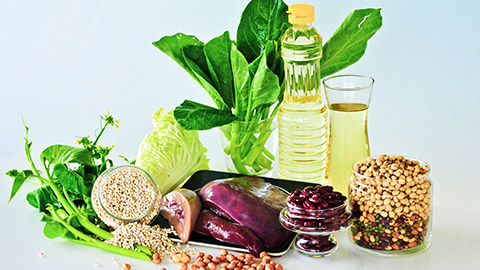
Molybdenum's main function is in preventing toxins from building up in the body and activating the enzymes that break those harmful toxins down. The kidneys help in regulating molybdenum in the body and excrete the excess through the urine tract.
Dietary sources: molybdenum is found in milk, cheese, cereal grains, legumes, nuts, leafy vegetables and organ meats
RDA: 45 μg
Stored: molybdenum is stored in the liver, kidney, adrenal glands, and bone
Deficiency: NIL
Toxicity: symptoms include a rise of the amount of uric acid in the body which can then cause gout.
Molybdenum benefits
- metabolises toxins then prevents toxins from building up in the body and excreting them through urine
- produces energy in the body
- protects cells, by activating antioxidants
Manganese
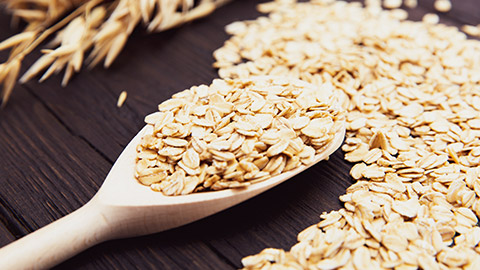
Manganese aids in the removal of toxins and activating the enzymes that break them down, much like Molybdenum. Manganese is required for the normal function of the brain, nervous system and many other enzyme processes that take place in the body, as well as metabolising nutrients, cholesterol, and carbohydrates. The body stores manganese however it does not produce therefore it need to be gained through diet. Manganese is only required in small amounts.
Dietary sources: manganese can be found in whole grains, oysters, mussels, nuts, rice, leafy vegetables, coffee, tea, and many spices for instance, black pepper.
RDI: 3 mg
Stored: manganese is stored in the liver, pancreas, bones, kidneys, and brain.
Deficiency: Impaired growth, glucose tolerance and reproductive function.
Manganese benefits
- supports regulate blood sugar
- assists in decreasing inflammation
- reduces premenstrual cramps
Selenium

Selenium produces antioxidant enzymes that help in preventing cell damage and boosts immunity to prevent illnesses or other infections from viruses. Selenium is also a key support in the maintenance of physiological functions such as a healthy immune system, optimal cognitive function and fertility in both males and females.
Dietary sources: selenium can be found it organ meats such as liver, yoghurt, seafood, brazil nuts, grains and cereal.
RDA: 55 µg
Stored: selenium is stored in muscle tissue and thyroid glands.
Deficiency: infertility and increase the symptoms of other viruses if infected.
Toxicity: can cause selenosis
Selenium benefits
- protects all cells as it acts as a powerful antioxidant
- improves in reduction of asthmatic symptoms
- boosts immunity
- protects against heart disease and risks of cancer
Chromium
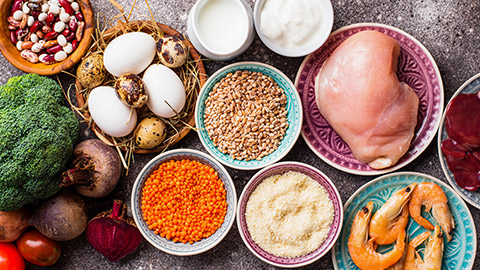
Chromium stimulates fatty acids in the stomach and the synthesis of cholesterol, as a result it helps to break down fats and carbohydrates when ingested. For this reason, chromium is involved in the control of glucose levels as it breaks down carbohydrates which is highly beneficial for diabetic glucose control and may also aid in weight loss.
Dietary sources: Milk and dairy products, vegetables, whole-grain products, liver, beef and poultry and fruits
RDI: 35 mg
Stored: chromium can be found in liver, spleen, soft tissue, and bone
Deficiency: impairs the body's ability to control glucose levels and can also impact on cholesterol levels.
Toxicity: NIL
Chromium benefits
- Aids in controlling the glucose levels of type two diabetes
- May enhance muscle mass,
- May assist in weight loss weight loss.
Fluoride

Fluoride plays a role in developing strong and healthy bones and teeth. Minimal sources contain fluoride, those which do, typically obtained the fluoride from the water they were cooked in.
Dietary sources: fluoride can be found in fluoridated water, tea, sardines and prawns, grape juice, jelly, soda and raisins. Additionally, cryolite, a common pesticide used on fruits and vegetables contains fluoride and transfers this onto nonorganic produce.
RDI: (women) 3mg (Men) 4mg
Stored: fluoride is mostly stored in bones and teeth while the remainder gets flushed out through the body’s urine
Deficiency: bone disorders and dental cavities
Toxicity: Nausea, abdominal pain, and vomiting, diarrhea, excessive salivation, tearing, sweating and overall weakness can occur if over 5mg.kg of body weight is consumed.
Fluoride benefits
- Aids in general oral health
- Prevents osteoporosis
- Avoids calcifications of ligaments
Iodine

Iodine assists in the production of thyroid hormones that help in balancing the body’s metabolism that influences weight gain and loss. Thyroid hormones also aid in functions contributing to the growth of bones and brain development of a foetus during pregnancy.
Dietary sources: Iodine is found in fish, seaweed and other seafood, dairy products, cereal and grain foods, fruits, vegetables (depending if soil is iodised), Iodised salt and processed foods.
RDI: 150 μg
Stored: iodine is stored in the thyroid gland
Deficiency: can result in an enlarged thyroid gland on the neck, fatigue, constipation and sensitivity to cold temperatures.
Toxicity: NIL
Iodine benefits
- Aids in promoting thyroid health.
- Reduces risk for goiters (enflamed thyroid gland).
- It can treat thyroid cancer.
- Assists with the neurodevelopment during pregnancy.
- May help treat fibrocystic breast disease.
Copper
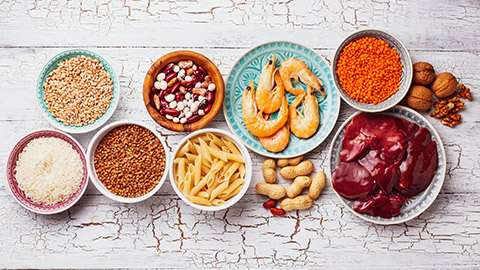
Copper plays a major role in the growth, development, and maintenance of the brain, connective tissue, bones, the heart, and other body organs. Since it influences so many aspects of the health in the human body, it is not hard to see that it will contribute immensely in preventing serious illnesses and disease such as heart disease or osteoporosis. In addition to that, copper also supports the performance of essential metabolic functions in the human body.
Dietary sources: copper is found in liver. Seeds, nuts, Leafy greens, organ meats, oysters and dark chocolate
RDI: 900 μg
Stored: copper is found in muscles and bones
Deficiency: eating too much zinc can interfere with copper absorption. Copper deficiency can result in becoming celiac and in symptoms such as fatigue and weakness, low immunity, weak and brittle bones, problems with memory and learning, difficulties walking, sensitivity to cold temperatures, pale skin and loss of vision.
Toxicity: headaches, fever, fainting, general unwell feeling, vomiting, diarrhea, black stools.
Copper benefits
- Prevents cardiovascular disease and osteoporosis
- Boosts immunity
- Maintains healthy bones and blood vessels
- Like vitamin C, it contributes to the absorption of iron, therefore assists in preventing iron deficiencies when taken with iron.
Supplements

In New Zealand, $30 million is spent on supplements yearly. People take supplements for various reasons. These are:
- Cold and flu preventative
- Improve general health/well-being
- Friends taking them
- Suggested by pharmacy/ store
- Read in magazines: Well- marketed, where people can identify with symptoms. E.g. "Are you feeling low? Lacking in energy?"
Studies show:
- No benefit in taking iron supplements unless diagnosed with iron deficiency.
- Vitamin supplements have no benefit to well-nourished people.
- Nutrients are best absorbed from food + phytochemicals (plants)
- Supplements can be harmful in toxic amounts
- Supplements are expensive
- All needed nutrients can be gained from a well-planned diet
In this topic, we focused on the role of vitamins and minerals and their contribution to a nutritious diet. You learned about:
- vitamins
- water-soluble and fat-soluble vitamins
- fortified food & supplements
- minerals
- major minerals
- trace minerals
- supplements
